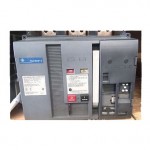General Electric Circuit Breaker Emergency on a Saturday
Posted on March 14th, 2017 in Circuit Breakers | No Comments »
On a recent Saturday afternoon, one of our field service supervisors received a call on his cell phone while he was at home. MIDWEST offices are closed on the weekends, but the supervisor was on-call; as such, our phone system redirects incoming calls to whoever is on-call.
The person on the other end was frantic. We finally got the facts from him. We found out he was an electrician from a division of a huge four billion dollar fortune 500 company. He said he had an emergency there. He had been calling dozens of electrical firms all over the country. He said not a single person answered, during which he had grown more and more desperate.
Apparently a model SSF16B216 (1600 Amp 600 Volt) General Electric circuit breaker had been turned off to perform some routine maintenance on downstream devices.
As can be seen from the picture, this “Insulated Case” style breaker has a 10” long silver pump handle that compresses a huge spring (think of a small version of a car’s suspension coil spring) through gearing, a pawl and a ratchet. The user then pumps the long handle 5 or 6 times. Each pump compresses the very strong spring a little more; the pawl and ratchet hold the spring back for the next pump. Once the spring is fully pumped up (compressed), the spring is said to be “charged”. Then the user presses the little black button labeled “PUSH ON”, which releases the spring, causing the main contacts to forcefully slam together, thus closing the breaker. The contacts need to forcefully slam together so as to minimize contact bounce, which would cause unacceptable arcing during the bounce. This same action also charges smaller springs that will cause the breaker to open when the current exceeds the trip settings or if manually opening is required which is accomplished by pressing the little red button labeled “PUSH OFF”.
Now that the maintenance work was finished, they had tried to close the breaker, as their next shift was starting. But no matter what they tried, the breaker would not charge the closing spring, so the plant could not operate. As such, they were losing $2,000 per minute ($120,000 per hour, or $3,000,000 per day). It’s easy to see why they were frantic to get some help.
Upon learning the company’s plight, our supervisor walked the customer through the necessary steps to reset the breaker. It turned out that the reason the customer could not reset the breaker originally, is because a part on the breaker had failed. Fortunately, MIDWEST has seen this same failure before, so we knew exactly how to circumvent the problem. Decades of use (and heating) had degraded a large, elastomeric end-stop called a “spring bumper”. Its purpose is to limit the travel of the pawl on the ratchet gear which charges the main actuator spring. The defective spring bumper caused the pawl to go into an over-travel situation so it couldn’t contact the ratchet tooth to pump up the closing spring. Thus, the breaker was made incapable of being closed again.
On the phone, we walked the customer through an improvised procedure that allowed him to manually circumvent the degraded spring bumper, and to finally charge the closing spring and close the breaker, powering up his factory. The customer was absolutely ecstatic. Not only was he finally able to get a real live person to talk to on a Saturday, but we knew exactly what to do to get him over his emergency, right then and there.
Afterwards, we looked at the times of the telephone call, starting from when we first picked up the phone to when the customer successfully closed the breaker and ended the call. From beginning to end, the call was only 50 minutes. And on a Saturday when we are closed!
On Monday, he called back to profusely thank us in very glowing terms.
Our experience and dedication saved the day again.
